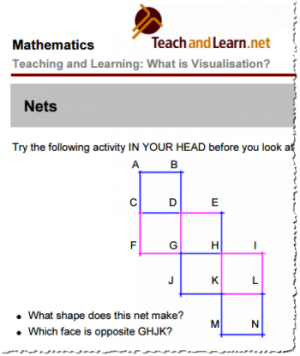Using visualisation in maths teaching: Difference between revisions
No edit summary |
No edit summary |
||
| (23 intermediate revisions by 4 users not shown) | |||
| Line 1: | Line 1: | ||
{| | {{ResourcePageGroupMenu|OU Teach Learn}} | ||
| | {{Rinfo | ||
|type= Teacher Education | |||
| | |||
| | |attribution={{OpenLearn}} | ||
| | |title=Using visualisation in maths teaching | ||
| | |topic=Visualisation | ||
| | |subject= | ||
| | Maths, |resourcenumber=TE012 | ||
|- | |image=visualising1.png | ||
| | |age=primary, Primary, Higher, Secondary, secondary | ||
| | |content=This is an Open University web tutorial with exercises to explore and explain visualisation. Imagery is a powerful force for perception and understanding. Being able to see something mentally is a common metaphor for understanding it. Some people can close their eyes and “see” a picture but, for others, it has much more to do with imagining, than seeing. Try to picture a cube, the seven-times table, a graph of sin x. | ||
|strategy= | |||
| | |toc= | ||
| | * Learning outcomes | ||
* Visualisation - a powerful force for perception and understanding | |||
* Starters - visualisation exercises | |||
| | * What does visualisation mean? | ||
| | * In the classroom | ||
| | * Conclusion | ||
| | * Next steps | ||
| | * References | ||
| | * Acknowledgements | ||
|} | |tagline=Thinking about visualisation in education. | ||
|Learning Objectives= | |||
* Engaging in a number of activities that involve visualisation and learning from your own experiences what visualisation means. | |||
* Learning the views of a well-known mathematics educator on visualisation and comparing your views with those of other secondary-school mathematics teachers; | |||
* Learning ways that visualising could be incorporated into your classroom and consider resources that might be useful. | |||
|additional resources= | |||
|useful information= | |||
|related resources= | |||
|other= | |||
|format= | |||
|resources=A study unit with exercises as [http://openlearn.open.ac.uk/course/view.php?id=2524 PDF documents] (Part of the Teach and Learn series from the Open University) | |||
|final=yes | |||
}} | |||
[[Category:Primary]][[Category:Secondary]][[Category:Teacher Education]] [[Category:Maths]][[Category:External Resource]] | |||
Latest revision as of 11:30, 10 December 2012
About. This is an Open University web tutorial with exercises to explore and explain visualisation. Imagery is a powerful force for perception and understanding. Being able to see something mentally is a common metaphor for understanding it. Some people can close their eyes and “see” a picture but, for others, it has much more to do with imagining, than seeing. Try to picture a cube, the seven-times table, a graph of sin x.
Pedagogical content. This unit looks at visualisation(ta) as it relates to mathematics, focusing upon how it can be used to improve learning. It also identifies ways in which to make more use of visualisation within the classroom. (edit)
| Resource details | |
| Title | Using visualisation in maths teaching |
| Topic | [[Topics/Visualisation|Visualisation]] |
| Teaching approach | [[Teaching Approaches/Visualisation|Visualisation]] |
| Learning Objectives |
|
| Subject | [[Resources/Maths|Maths]] |
| Age of students / grade | [[Resources/Secondary|Secondary]], [[Resources/Primary|Primary]], [[Resources/Higher|Higher]] |
| Table of contents |
|
| Files and resources to view and download | A study unit with exercises as PDF documents (Part of the Teach and Learn series from the Open University)
|

